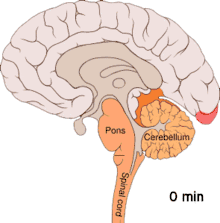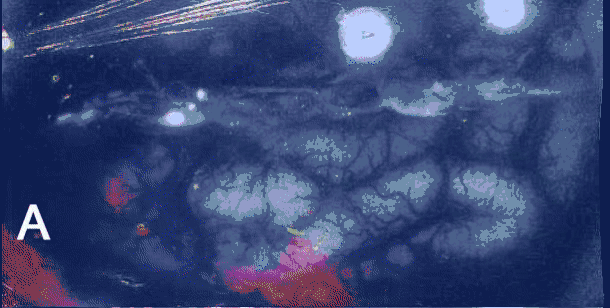Cortical spreading depression
Cortical spreading depression (CSD) or spreading depolarization is a wave of electrophysiological hyperactivity followed by a wave of inhibition.[1] Spreading depolarization describes a phenomenon characterized by the appearance of depolarization waves of the neurons and neuroglia[2] that propagates across the cortex at a velocity of 1.5–9.5 mm/min.[3][4][5][6] CSD can be induced by hypoxic conditions and facilitates neuronal death in energy-compromised tissue.[7] CSD has also been implicated in migraine aura, where CSD is assumed to ascend in well-nourished tissue and is typically benign in most of the cases, although it may increase the probability in migraine patients to develop a stroke.[8] Spreading depolarization within brainstem tissues regulating functions crucial for life has been implicated in sudden unexpected death in epilepsy, by way of ion channel mutations such as those seen in Dravet syndrome, a particularly severe form of childhood epilepsy that appears to carry an unusually high risk of SUDEP.

Uses of the term
Neuroscientists use the term cortical spreading depression to represent at least one of the following cortical processes:
- The spreading of a self-propagating wave of cellular depolarization in the cerebral cortex.
- The spreading of a wave of ischemia passing through an area of cortex.
- The spreading of a wave of vasoconstriction following vasodilation and prolonged sustained vasoconstriction of contiguous cortical arterioles.[9]
The scintillating scotoma of migraine in humans may be related to the neurophysiologic phenomenon termed the spreading depression of Leão.[10]
Increased extracellular potassium ion concentration and excitatory glutamate contribute to the initiation and propagation of cortical spreading depression, which is the underlying cause of migraine aura.[11]
Chronic daily administration of migraine prophylactic drugs (topiramate, valproate, propranolol, amitriptyline, and methysergide) dose-dependently suppressed frequency of CSD induced by continuous cortical application of 1 M KCl solution.[12] However lamotrigine (a drug with specific anti-aura action, but no efficacy in migraine in general) has a marked suppressive effect which correlates with its rather selective action on the migraine aura. Valproate and riboflavin were shown to have no effect on the triggering of cortical spreading depression though they are effective in migraine without aura.[13] Taken together, these results are compatible with a causal role of cortical spreading depression in migraine with aura, but not in migraine without aura.
The folded structure of the cerebral cortex is capable of irregular and complex CSD propagation patterns. The irregularities of the folded cortex and the vasculature promote the presence of re-entrance waves, such as spirals and reverberating waves.[5] The expansion of the wave then is less predictable and it is affected by the concentration of different molecules and gradients on the cortex.
Its triggers and propagation mechanisms, as well as clinical manifestations of CSD, are a therapeutic target to reduce brain damage after a stroke or brain lesion.[14][15]
See also
Notes
- Dodick DW & Gargus JJ (August 2008). "Why migraines strike". Scientific American.
- Chuquet, Julien; Hollender, Liad; Nimchinsky, Esther A. (2007-04-11). "High-resolution in vivo imaging of the neurovascular unit during spreading depression". The Journal of Neuroscience. 27 (15): 4036–4044. doi:10.1523/JNEUROSCI.0721-07.2007. ISSN 1529-2401. PMC 6672520. PMID 17428981.
- Ayata, Cenk; Lauritzen, Martin (2015-07-01). "Spreading Depression, Spreading Depolarizations, and the Cerebral Vasculature". Physiological Reviews. 95 (3): 953–993. doi:10.1152/physrev.00027.2014. ISSN 1522-1210. PMC 4491545. PMID 26133935.
- Hartings, Dreier; Jed, Jens (2017-05-01). "Recording, analysis, and interpretation of spreading depolarizations in neurointensive care: Review and recommendations of the COSBID research group". Journal of Cerebral Blood Flow and Metabolism. 37 (5): 1595–1625. doi:10.1177/0271678X16654496. ISSN 1559-7016. PMC 5435289. PMID 27317657.
- Santos, Edgar; Schöll, Michael; Sánchez-Porras, Renán; Dahlem, Markus A.; Silos, Humberto; Unterberg, Andreas; Dickhaus, Hartmut; Sakowitz, Oliver W. (2014-10-01). "Radial, spiral and reverberating waves of spreading depolarization occur in the gyrencephalic brain". NeuroImage. 99: 244–255. doi:10.1016/j.neuroimage.2014.05.021. ISSN 1095-9572. PMID 24852458.
- Porooshani H, Porooshani GH, Gannon L, Kyle GM (2004). "Speed of progression of migrainous visual aura measured by sequential field assessment". Neuro-Ophthalmology. 28 (2): 101–105. doi:10.1076/noph.28.2.101.23739.
- Dreier, Jens P.; Reiffurth, Clemens (2015-05-20). "The stroke-migraine depolarization continuum". Neuron. 86 (4): 902–922. doi:10.1016/j.neuron.2015.04.004. ISSN 1097-4199. PMID 25996134.
- Santos, Edgar; Sánchez-Porras, Renán; Dohmen, Christian; Hertle, Daniel; Unterberg, Andreas W.; Sakowitz, Oliver W. (2012-04-01). "Spreading depolarizations in a case of migraine-related stroke". Cephalalgia: An International Journal of Headache. 32 (5): 433–436. doi:10.1177/0333102412441414. ISSN 1468-2982. PMID 22407661.
- Brennan KC, Beltrán-Parrazal L, López-Valdés HE, Theriot J, Toga AW, Charles AC (2007). "Distinct vascular conduction with cortical spreading depression". Journal of Neurophysiology. 97 (6): 4143–4151. doi:10.1152/jn.00028.2007. PMID 17329631.
- Leão AAP (1944). "Spreading depression of activity in the cerebral cortex". J Neurophysiol. 7 (6): 359–390. doi:10.1152/jn.1944.7.6.359.
- Richter and Lehmenkühler (2008)
- Ayata; et al. (Apr 2006). "Suppression of cortical spreading depression in migraine prophylaxis". Ann Neurol. 59 (4): 652–61. doi:10.1002/ana.20778. PMID 16450381.
- Bogdanov; et al. (Feb 2011). "Migraine preventive drugs differentially affect cortical spreading depression in rat". Neurobiol. Dis. 41 (2): 430–5. doi:10.1016/j.nbd.2010.10.014. PMID 20977938.
- Sánchez-Porras, Renán; Santos, Edgar; Schöll, Michael; Stock, Christian; Zheng, Zelong; Schiebel, Patrick; Orakcioglu, Berk; Unterberg, Andreas W.; Sakowitz, Oliver W. (2014-09-01). "The effect of ketamine on optical and electrical characteristics of spreading depolarizations in gyrencephalic swine cortex". Neuropharmacology. 84: 52–61. doi:10.1016/j.neuropharm.2014.04.018. ISSN 1873-7064. PMID 24796257.
- Sánchez-Porras, R.; Zheng, Z.; Santos, E.; Schöll, M.; Unterberg, A. W.; Sakowitz, O. W. (2013-08-01). "The role of spreading depolarization in subarachnoid hemorrhage". European Journal of Neurology. 20 (8): 1121–1127. doi:10.1111/ene.12139. ISSN 1468-1331. PMID 23551588.
References
- "Cortical spreading depression causes and coincides with tissue hypoxia", Nat Neurosci. 29 April 2007, Takano T, Tian GF, Peng W, Lou N, Lovatt D, Hansen AJ, Kasischke KA, Nedergaard M., Department of Neurosurgery, University of Rochester Medical Center, Rochester, New York.
- "A delayed class of BOLD waveforms associated with spreading depression in the feline cerebral cortex can be detected and characterised using independent component analysis (ICA)", Magn Reson Imaging. 21 November 2003, Netsiri C, Bradley DP, Takeda T, Smith MI, Papadakis N, Hall LD, Parsons AA, James MF, Huang CL., Physiological Laboratory, University of Cambridge, Cambridge, UK.
- "Cortical spreading depression (CSD): A neurophysiological correlate of migraine aura", Schmerz, May 17, 2008, Richter F, Lehmenkühler A.
Further reading
- braintsunamis.com - Spreading Depolarization and Spreading Ischemia
- COSBID.org The Co-Operative Studies on Brain Injury Depolarizations is an international research consortium focused on the role of spreading depolarizations in acute neurologic injury
- Spreading+Cortical+Depression at the US National Library of Medicine Medical Subject Headings (MeSH)
- Dodick, David W.; J. Jay Gargus (August 2008). "Why Migraines Strike". Scientific American. Scientific American Inc. pp. 56–63. ISSN 0036-8733. Retrieved 2008-08-16.
- Neurosciences Critical Care Unit, Cambridge, UK. "Spreading Cortical Depolarisation". cambridgecriticalcare.net. NCCU Education. Retrieved 20 October 2014.CS1 maint: multiple names: authors list (link)
